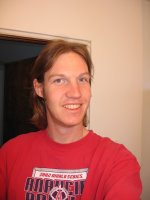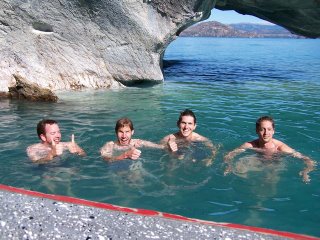Resumen 4: El Observatorio
Last February 16-19, I observed at the 0.9 meter telescope on Cerro Tololo. It was my only observing experience during my time in Chile. Observing consists of pointing the telescope at different targets, taking exposures (which can range from a few seconds to several minutes each), looking at the resulting images to make sure everything is working properly, and repeating this process all night! You stay up all night, sleep all day, and get well-fed!
The project I observed for was to calibrate the WMAP data for foreground contamination by our own galaxy. Essentially the idea is that the WMAP mission has measured the cosmic microwave background (CMB) radiation across the entire sky, which is indicative of conditions in the universe very shortly (~100,000 yrs.) after the Big Bang. The data gives astronomers an idea of the large scale conditions of the universe and provides insight into the origins and fate of the universe!
It is very exciting data, but there may be problems with foreground contamination, which is where I come in. In my observing, I took polarization observations of Milky Way halo stars (the stars in our own galaxy that are the farthest away from us). The idea is that if we can obtain measurements of halo stars across the entire sky, then we will have an excellent idea of how the dust in our galaxy varies with sky position and can use that information to adjust the CMB data to better-represent the true CMB spectrum. Although there may be other sources of contamination besides our own galaxy, this is undoubtedly a major contributor, and correcting it is crucial to enable astronomers to confidently draw conclusions from the WMAP data.
I observed for 4 nights, the last three of which I spent observing alone! The nights lasted from about 9 pm to around 6 am, which actually isn't too bad compared to the LONG Winter nights! Enjoy the pictures!

I arrived to Tololo the afternoon of the 16th...tired already, but still looking forward to 4 sleepless nights!


The evenings brought clouds that were beautifully colored by the setting sun. Luckily, these clouds went away by nighttime, making for great observing conditions.

Enjoying the setting sun. Here, I'm standing next to the 0.9 m dome, and preparing to spend all night inside!


The setting sun meant time to get to work!!

Getting the night started with some calibration frames (taking images of stars with known polarization...to later calibrate the rest of the stars). Everything about the telescope is controlled by these computers in the control room, which is situated directly beneath the telescope. The two biggest things I had to continually control were the telescope pointing and the camera (each done on a separate computer).


In all her glory, the 0.9 m scope. We spent 4 great nights together. This is probably one of the smaller telescopes in use in Astronomy today. It has been in operation since the late 60s. But she still works like a charm!

After observing all night, it was spectacular to emerge from the control room to a setting Venus...

...a beautiful moon (here, seen over the 4 m telecope dome)...

...and then to head off to bed until the next afternoon!




















